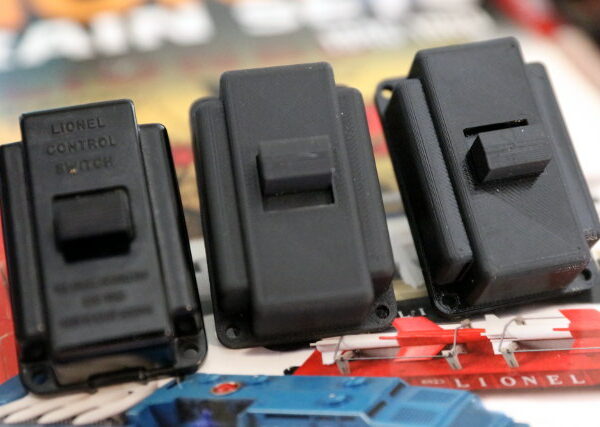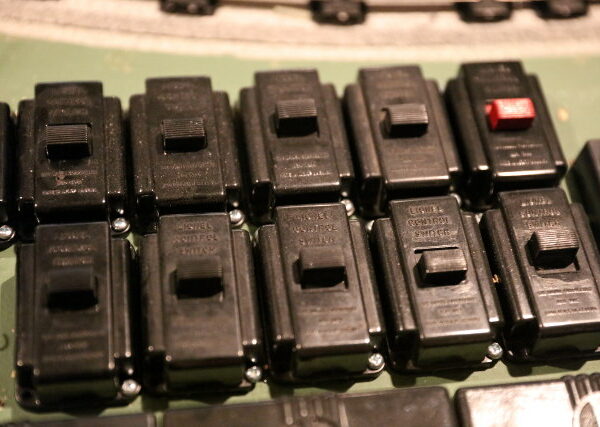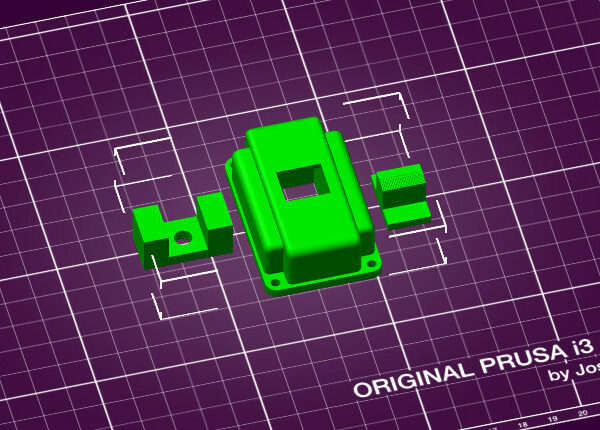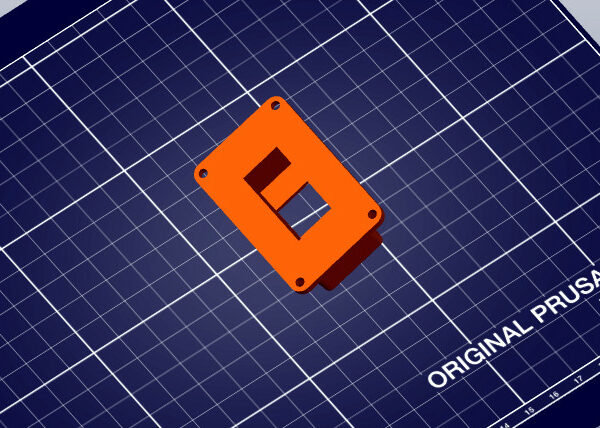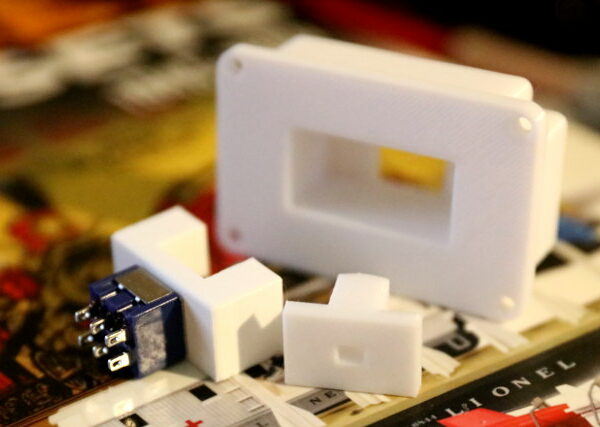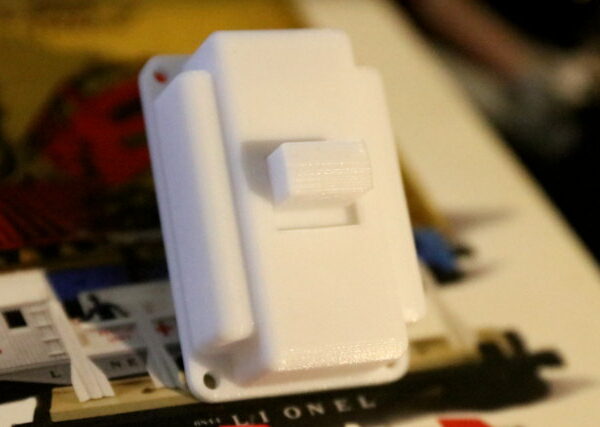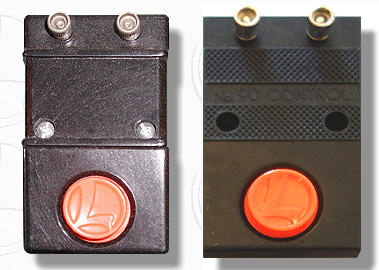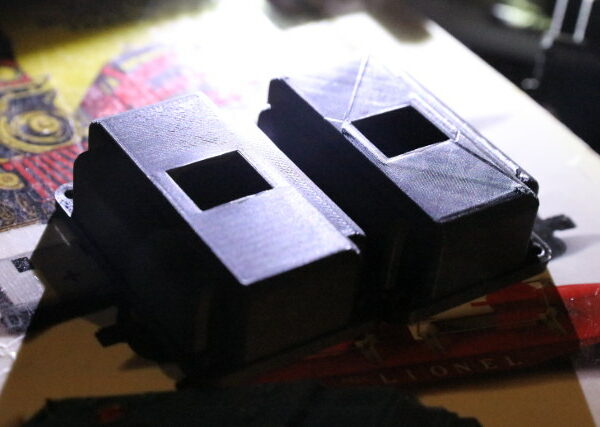Lionel 364c control switch clone
Admittedly this is not as sexy as many things to be made, but this is quite functional and in a real-world situation it both cosmetically and electrically matches the original.
A bit of context for those not into O scale model railroading. The Lionel 364c control switch has been around since the early 1950s and is very commonly used in model railroad control panels as an on-off switch for controlling accessories, track sections and anything else that needs to be turned on and off. It's very common in layouts which are based on postwar O scale.
It's no longer made, but usually commonly available. Used ones in good condition can be had at train shows for a few dollars each. New-old-stock ones can also be obtained at prices in the range of extortive to confiscatory. 😉 Some commercial clones, re-issues and variants are in the wild (such as the one below with the red toggle) often at reasonable prices.
I usually pick up a few to several of them up whenever I go to a larger train show. That's the problem. Due to the pandemic I have not been to a train show since March of this year, just before the Covid hit the fan.
A few days ago I started installing the power plant, also featured in this section. I needed two controller switches, one for the heater of the smoke generator, and another for the fans of the smoke generator. I found that I had ZERO unused ones in the parts boxes.
I checked Ebay and Amazon and found plenty of them available in the US $20.00 and up range for those in used but good condition. There are some questionable ones priced lower, mostly those with broken and missing pieces around the mounting holes, but of course none that I could hold in my hand and inspect before buying.
Prusa to the rescue!
It took about an hour and a half to draft the body of the switch. As you can see in the bottom photo, it's really a 'wrapper' around a very common mini toggle switch. A quick draft-resolution proof of concept test print confirmed that the idea is workable. After a few tweaks to the toggle and the internal bracket used to hold the actual switch, I was able to produce a working model that has not only the look, but the feel of the original. The 'snap' of the 3d printed clone is amazingly similar to that of the genuine Lionel 364c.
Immediately below is a genuine Lionel 364c on the left, a clone of PLA in the center, and a clone of PETg on the right. The PETg has a sheen that more closely matches the original. Yes, some 'brush strokes' are showing, but they are not as obvious in real life as they are with the particular light in the photo. I'm sure that some sanding would remove them.
I guess it would be possible to add the printed logo, but I probably won't. I considered printing one in ABS and trying to vapor smooth it but again probably won't. I tried a quick print using the 'ironing' function in Cura, but the result was, speaking freely, butt-ugly, worse than the relatively minor brush strokes.
I think this came out rather well.
RE: Lionel 364c control switch clone
"confiscatory" ooh, nice word, must work that into a conversation.
RE: Lionel 364c control switch clone
"confiscatory" ooh, nice word, must work that into a conversation.
'Confiscatory' is a very appropriate term to use when describing the pricing of many unused new-old-stock postwar model railroad items. Some new-in-box train sets that originally retailed in the US$30-50 range can sell on the collector market for over $10,000.00. It's amazing what collectors will pay. (I am a 'runner', not a collector, as I buy the items to run them, to use them as intended.)
For many railroad cars and accessories, if the original box is with it, and in good condition, the price on the collector market can often times double.
RE: Lionel 364c control switch clone
Nice, would you be so kind to show a picture of the inside of your switch (how you mount the movable part to the cover?) and how the rocker switch is controlled by the movable part.
Stock MK4S
RE: Lionel 364c control switch clone
Nice, would you be so kind to show a picture of the inside of your switch (how you mount the movable part to the cover?) and how the rocker switch is controlled by the movable part.
Yes, when I print another one I will. I just glued the last one I printed together this morning before I checked the forum.
Meanwhile I'll describe it and give you some screenshots.
The actual switch is not a rocker switch. It's a generic miniature toggle switch of the type usually found in the parts junk box of anyone who works with electronics (pictured in the third photo above). Since you mentioned a rocker switch, yes, I'm sure a rocker switch could be used with better results (see the compromise below) but I don't have any on hand currently.
The assembly has three pieces. The main body, the toggle, and a bracket to hold the switch. The toggle has (not visible here) a small rectangular slot into which the end of the toggle of the actual switch fits. By placing the end of the toggle of the actual switch toward the bottom of the printed toggle, the 'throw' distance is very similar to that of the original Lionel controller switch.
The movable toggle is held in place between the extensions of the bracket and the inside surface of the top of the switch body. This is a bridged area of the body, printed without supports, and has very little sag. Trial and error gave the exact size of the 'U' part of the bracket in order to allow the toggle to move freely without binding and without appreciable play.
The actual switch is fastened with the usual nut into the hole of the bracket with the toggle between the 'U' part of the bracket and parallel to it. To assemble, the toggle is first inserted into the body and then the bracket-switch assembly is inserted and the toggle of the actual switch is aligned with the slot on the 3d printed toggle. The bracket is then glued into the body. I used Aileen's The Ultimate adhesive, which is a very 'forgiving' glue so the switches can be disassembled if needed.
Now for the bad news, one compromise which I conveniently neglected to include in my original posting. 😉
There is no way the toggle switch will fit into the body of the 364c clone and let the assembly lie flush. I thought of remixing it to use a microswitch instead, but I want to get the power plant project completed and I have several of those toggle switches on hand. It needs a 11/16 (about 17mm) hole to be bored into the table in order to mount it flush. This is not visible at all, but the hole is indeed larger than the one that's usually used for the wiring of the original 364c.
RE: Lionel 364c control switch clone
That is a really good idea! no photo's needed your detailed explanation and screenshots explained it. Big thank you!
Stock MK4S
RE: Lionel 364c control switch clone
Here, as promised, showing the 'guts' of the thing, with a twist.
I thought of printing the toggle part in white to identify one particular control, and then figured WTF, just go ahead and print the whole thing white. The great thing about 3d printing is that if you want to see how something will turn out in a different color, it's as simple as unloading and reloading filament and the cost of the print is really negligible.
RE: Lionel 364c control switch clone
beautiful solution, thank you for sharing. for an even nicer (if possible) touch you could try the beta Prusa Slicer and use monolithic infill and ironing (or if that leap is too big; play with the angle of the infill (or rotate the part 45 degrees))
Stock MK4S
RE: Lionel 364c control switch clone
Albino? 🙂
RE: Lionel 364c control switch clone
I think they are beautiful and clean, Rapid Retro Prototyping.
Very nice
The Filament Whisperer
RE: Lionel 364c control switch clone
beautiful solution, thank you for sharing. for an even nicer (if possible) touch you could try the beta Prusa Slicer and use monolithic infill and ironing (or if that leap is too big; play with the angle of the infill (or rotate the part 45 degrees))
Yes, I think it's a very nice looking switch, and the streamline moderne styling is very typical of the era. Even after 60-some years it's commonly used by model railroaders today and obviously sought after, reflected by the Ebay price point.
Another popular Lionel control switch, this one being a momentary contact one as opposed to off or on, is the 90C, pictured below. IIAC the 90c came out maybe 1957 or so. As with the 364C, they are very common at train shows and usually reasonably priced. I'm sure it would be fairly easy to clone those as well, and the stock Prusa(ment) orange filament would be a good match for the button.
Let me see if I can find a version of the new slicer which works on one of my machines. Last time I tried (some time ago) the binary I tried complained about missing/old libraries and when I gave a quick shot to building it, I ran into a mess of requirement/version issues and I did not particularly feel like slogging through resolving all of them.
I sure wish those who have working build systems (on Linux) would be more eager to share their specific version and/or environment info!
RE: Lionel 364c control switch clone
Update: The latest beta binary I downloaded a few minutes ago does indeed load and execute (at least it got through the config) so when the current print finishes I'll load some black PLA and try a print with monolithic infill and ironing.
Film at 11.
RE: Lionel 364c control switch clone
Ok, here's your film before 11. 😉
Bottom line, I think I'm going to like the new ironing function in PS. For this project it worked a LOT better than the ironing function in Cura.
I do think, however, that I'll need to tweak the Z cal and/or the ironing parameters a bit, as the 'brush strokes' are showing through the ironing in part of the print.
The photo below shows the switch body done with the ironing function in PS on the left, and the one done with the ironing function in Cura on the right (which I rescued from the plastic scrap box for this photo). It took some playing with the light and the camera angle to show the detail I wanted to show on the top surfaces. I ended up with the light and the camera angled so it's almost backlit.
As you will see, the lower flat surface on the top of the left body is almost perfect. I am impressed and I thank you for the suggestion. On the upper flat surface, however, the strokes are starting to show through, and at the very top on the right (not obvious in the photo) it looks like some left-to-right scratches. I'm sure some tweaking will help with this.
(As an aside, I assume you meant monotonic instead of monolithic.) 😉 😉
On the right is the one printed with the ironing function in Cura. As you can see the top is indeed smoothed, but with some ugly artifacts, as in two 45 degree lines on the flat surfaces and one oddball blemish at the bottom right of the hole for the toggle.
RE: Lionel 364c control switch clone
The result is beautiful (not unusual for your prints and designs 😀 ) and looks perfect to me. Thank you for sharing the results.
If the top half bothers you you could (water) sand it with 1000 grit paper
For the 90C switch I would use a "Light Touch Mini Button" like these: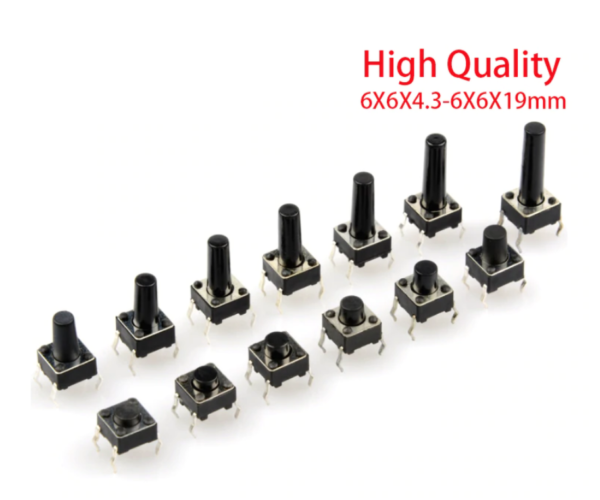
Stock MK4S
